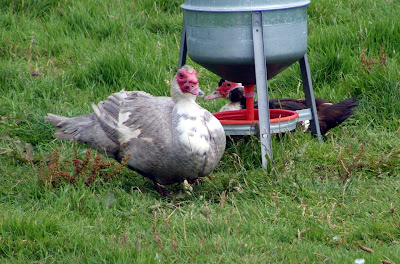The four birds on the right are Samson, Thelma, Louise and Delilah, our Muscovy
Ducks. Unlike "regular" domestic ducks, they are not descended from mallards.
The wattling around the face, more noticeable in the drake, is an obvious
physical difference. The don't quack like mallard type ducks. The drakes are virtually mute, making no more than a hissing sound, and the ducks make various pipping noises.
Their eggs take 35 days to incubate, unlike other ducks which take 28 (
see entries about Wee Curly elsewhere in this blog), and the offspring of a
muscovy/mallard cross will be infertile.
 We put 2 dozen of their eggs in the incubator 6 weeks ago. We know they are true Muscovies, as we have all parents, so we knew it was going to be a long incubation (5 weeks).
We put 2 dozen of their eggs in the incubator 6 weeks ago. We know they are true Muscovies, as we have all parents, so we knew it was going to be a long incubation (5 weeks).
The first hatched out 2 days early, and the last 2 days late. A few started, but never made it out. I suspect I had the humidity in the incubator too low (60%).
The small incubator has another 8 eggs due a week later (tomorrow!), and I have the humidity up at 74%. We'll see if that produces better results.











